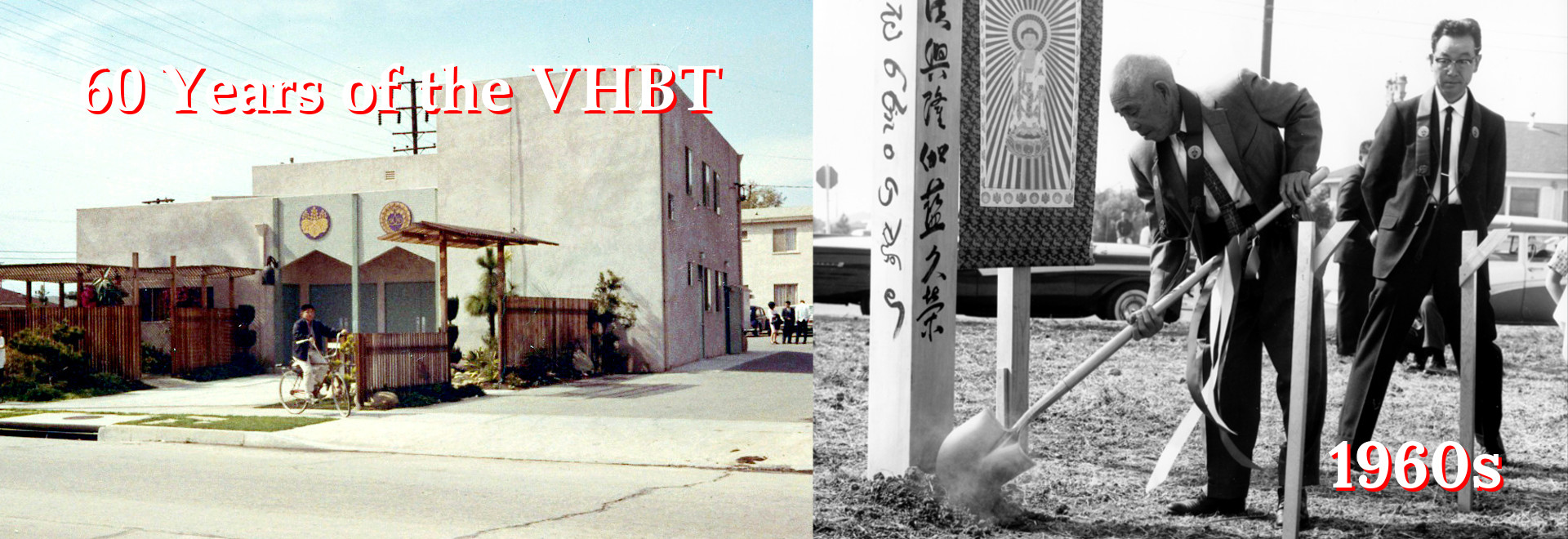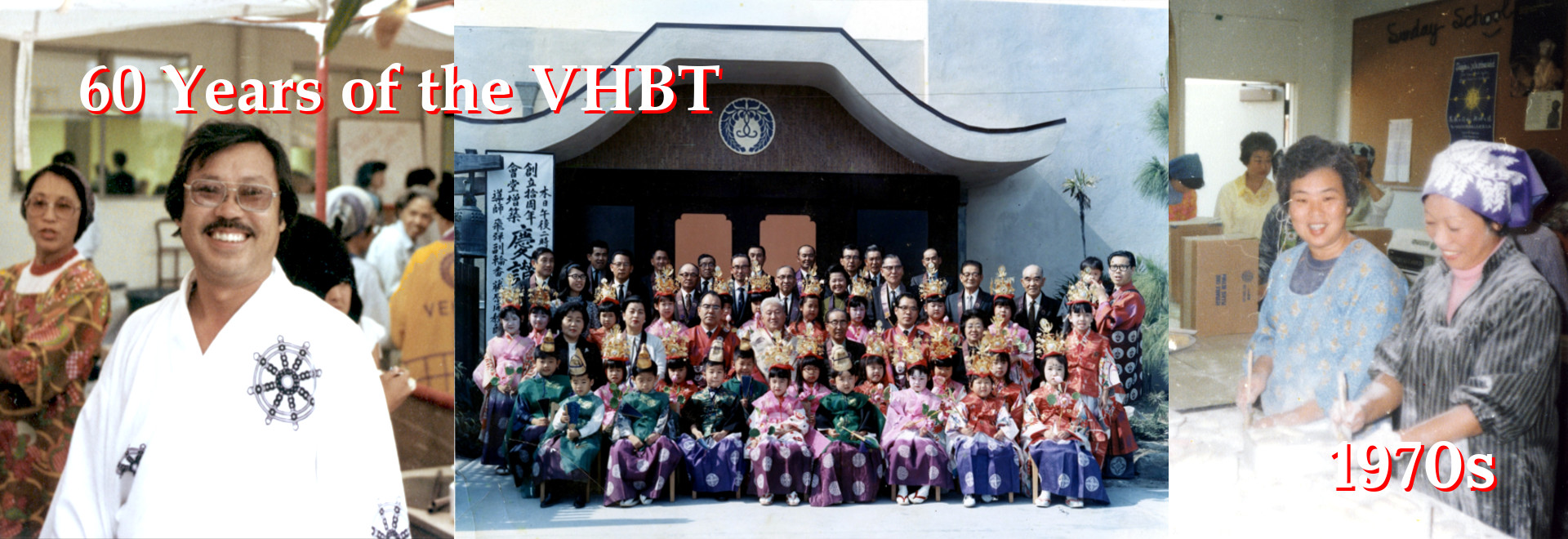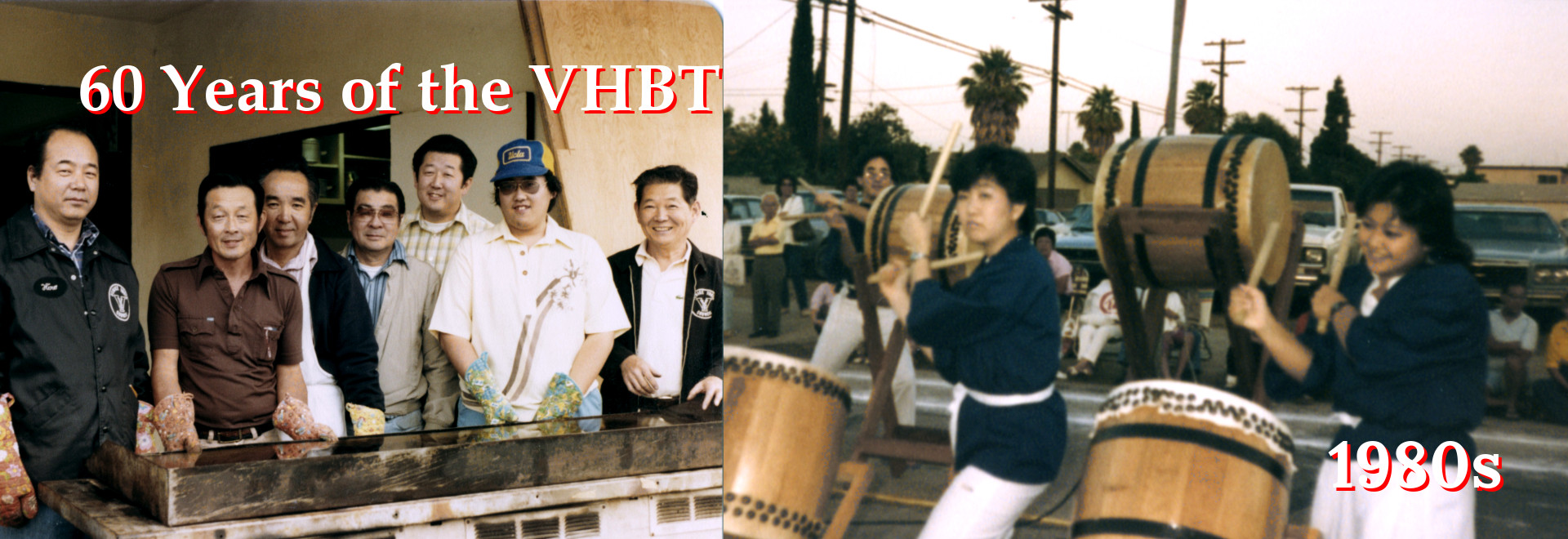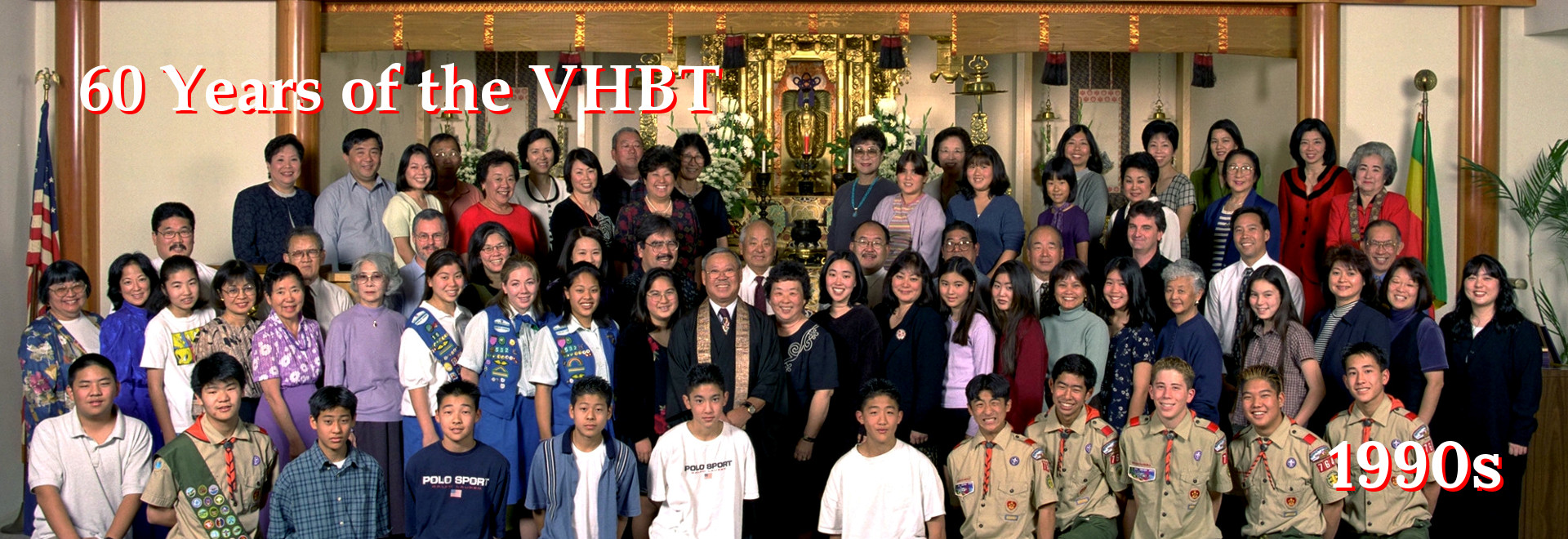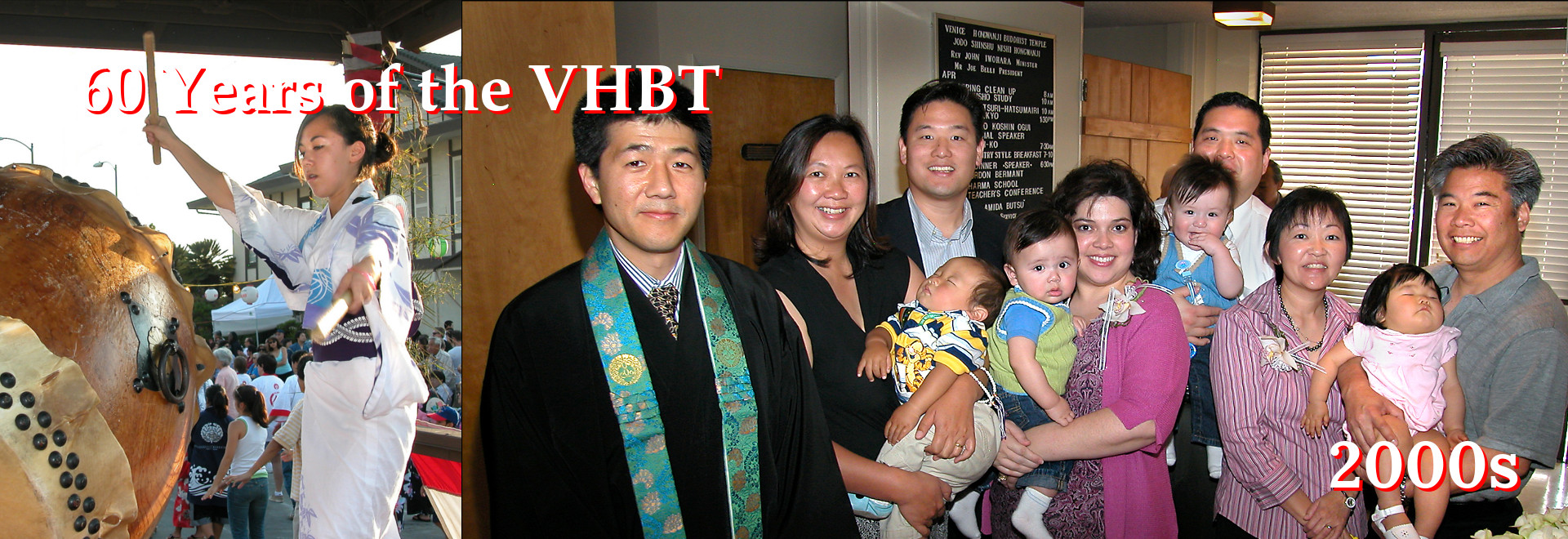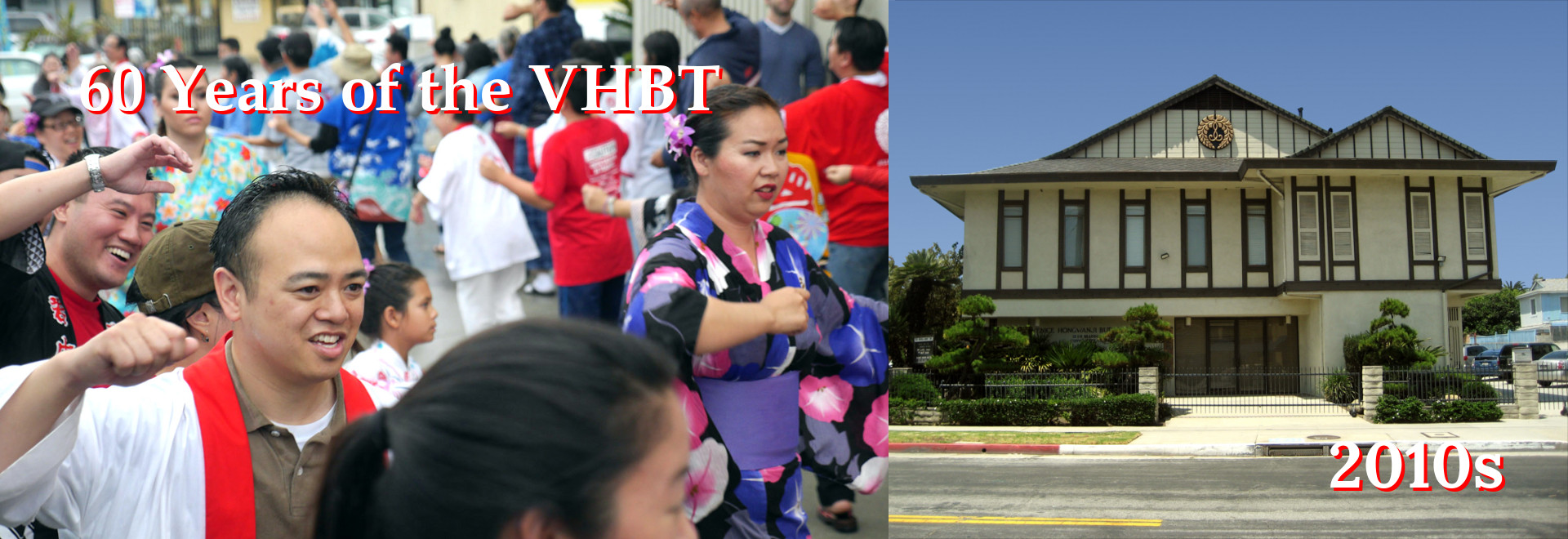In the beginning…
Moving to a new location…
Temple expansion…
The story continues…
At the present time…
Looking Towards the Future…
Our temple is the 61st member temple of the Buddhist Churches of America (B.C.A.). The BCA is comprised of around 60 member Temples and fellowships within the Continental United States (the State of Hawaii is organized as the Jodo Shinshu Mission of Hawaii). Following the Second World War several temples were forced to close. The B.C.A. is organized into 8 districts. The Venice Hongwanji is one of the 15 temples that comprises the Southern District Council of the B.C.A. The B.C.A. is headquartered in San Francisco and represents the Jodo Shinshu temples throughout the Continental United States. The World Headquarters can be found at the head temple of our denomination or the Jodo Shinshu Hongwanji-ha, Hongwanji found in Kyoto, Japan. The head, or mother temple is often simply referred to as “Nishi Hongwanji.” The Venice Hongwanji continues to be actively involved in the Southern District Council, the B.C.A., and the activities of the Hongwanji in Japan. The Venice Hongwanji is proud to have been a participant of the re-roofing project of the mother temple.
The Venice Hongwanji has a membership of approximately 150 families. The temple originally served the Japanese-American community residing in the Venice area of Los Angeles, and presently serves neighboring Culver City and other outlying areas such as southward into the South Bay and northward into West Los Angeles/Santa Monica.
In the beginning…
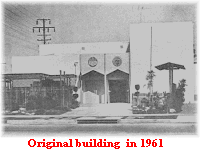 Buddhist activities in this area started in the early 30’s when Howakai services, under the sponsorship of the Los Angeles Betsuin, were held in private homes. Some of the families that opened their homes were the Hisaoka, Kamibayashi, Kamoto, Kato, Kiyohiro, Nakagiri, Okamoto, Onishi, Ozaki, Sugino, Tanaka, and Yamamoto families.
Buddhist activities in this area started in the early 30’s when Howakai services, under the sponsorship of the Los Angeles Betsuin, were held in private homes. Some of the families that opened their homes were the Hisaoka, Kamibayashi, Kamoto, Kato, Kiyohiro, Nakagiri, Okamoto, Onishi, Ozaki, Sugino, Tanaka, and Yamamoto families.
Dharma School services were started in the late 30’s with the ministers from the Los Angeles Betsuin participating. These services were held at the home of Kikuichi Sugino, on the Mesmer Ranch on Jefferson Boulevard, the present Playa Vista development. These activities continued until the beginning of the World War II in December, 1941.
Approximately three years after the termination of the war, Howakai services were resumed in 1948. As it was before the war, these services were held in private homes. These included such families as Hisaoka, Morita, Nakagiri, Okamoto, Ozaki, Shinmoto, Tanaka, and Yamamoto. However, it was not until 1955 that Dharma School activities were started. Reverend Shoki Mohri from the Betsuin, with the assistance of Mrs. Sumiye Watari, gathered twelve students at the Fukushima residence for the first service.
Moving to a new location…
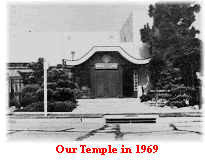 The Temple was founded as one of the missionary projects of the Los Angeles Betsuin in the late 50’s. For this, a property with two houses located on Culver Boulevard just west of Centinela Boulevard was purchased. Reverend Ryuei Masuoka, who would later become Rimban of the Los Angeles Betsuin, helped to establish the foundation for the temple as he and his family occupied the front house as the minister’s residence. The rear house was used for services and other temple activities. In January, 1960, a dedication service together with Hoonko Service was conducted for this newly established branch temple of the Betsuin.
The Temple was founded as one of the missionary projects of the Los Angeles Betsuin in the late 50’s. For this, a property with two houses located on Culver Boulevard just west of Centinela Boulevard was purchased. Reverend Ryuei Masuoka, who would later become Rimban of the Los Angeles Betsuin, helped to establish the foundation for the temple as he and his family occupied the front house as the minister’s residence. The rear house was used for services and other temple activities. In January, 1960, a dedication service together with Hoonko Service was conducted for this newly established branch temple of the Betsuin.
The Temple’s first Board Chairman was Kiyoshi Waki. A few months later, the Fujinkai (Buddhist Women’s Association) was formed with Mrs. Kazuko Watanabe as the first president. The first Sunday School Superintendent was Walter Kitagawa. The Adult Buddhist Association was organized in 1963 with Shig Tochioka as the first president.
With a more permanent location for the growing temple community to gather, the membership of the temple started to increase rapidly and new facilities had to be found.
With the financial backing of the Los Angeles Betsuin, a new property was purchased at the current 12371 Braddock Drive location in Culver City. The Groundbreaking Ceremony for the construction of a new temple building was held in September, 1962. The building was completed in the spring of 1963 and the Dedication Service was held on June 30, 1963.
During this time, Reverend Masuoka became the Fuku-rimban (Vice Rimban) at the Los Angeles Betsuin in 1961 and would be given the chief leadership role as Rimban in March, 1963. Because of his added responsibilities, in 1965 Reverend George Matsubayashi was assigned to the Venice Hongwanji from the Los Angeles Betsuin. Building on the foundation established by Rimban Masuoka, Reverend Matsubayashi’s innate ability to communicate with the young and the old brought with it another period of rapid growth for the temple.
Temple expansion…
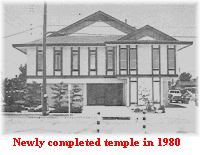 Within six years after moving into the new building, a 1,200 square foot expansion program was planned and completed in 1969. This included a new entry facade, a main entry lobby and larger accommodations on the second floor with six classrooms.
Within six years after moving into the new building, a 1,200 square foot expansion program was planned and completed in 1969. This included a new entry facade, a main entry lobby and larger accommodations on the second floor with six classrooms.
Many activities kept the Temple open almost every weeknight. Classes were held for sumi-e (Japanese brush painting), flower arrangement, shigin and shodo (Japanese calligraphy). An Accordion Band was organized. Cub Scout Pack 79, under Cubmaster Edward Morimoto and Den Mother Mrs. Victoria Morimoto was started in July 1970.
In September 1972, a minister’s residence adjacent to the Temple on Campbell Drive was purchased. Members, under the supervision of Mr. James Mayeda, did the repairs and re-modeling of the home, and also constructed a garage-storage building on the property soon after the purchase.
The story continues…
 In March, 1976, the Venice Hongwanji Buddhist Temple decided that it was now able to support its own minister and religious program; it became the 61st independent temple of the Buddhist Churches of America under the leadership of Reverend George Matsubayashi as its first resident minister and Sadamu Ueki as its first board president. As the temple continued to grow, the temple facilities were again expanded in 1979-1980. The dedication services for the newly expanded temple were held on June 1, 1980.
In March, 1976, the Venice Hongwanji Buddhist Temple decided that it was now able to support its own minister and religious program; it became the 61st independent temple of the Buddhist Churches of America under the leadership of Reverend George Matsubayashi as its first resident minister and Sadamu Ueki as its first board president. As the temple continued to grow, the temple facilities were again expanded in 1979-1980. The dedication services for the newly expanded temple were held on June 1, 1980.
In May of 1999, Reverend Nobuo Miyaji joined Venice Hongwanji Buddhist Temple as the resident minister when Reverend Matsubayashi assumed the position of Rimban at Los Angeles Hompa Honwanji Temple.
Prior to Reverend Miyaji’s assignment to the Venice Hongwanji, he was with the Los Angeles Hompa Hongwanji Buddhist Temple, and was serving as its interim Rimban. On June 1, 2003, Reverend Miyaji was transferred to the Fresno Betsuin to serve as their Rimban.
Upon the transfer of Reverend Miyaji, the temple faced its first serious challenge to survive. Being without the services of a resident minister for the first time, the temple was able to continue serving the religious needs of the temple community when Reverend Ben Mayeda agreed to temporarily come out of retirement and help the temple until a new resident minister could be found. The temple board, and in particular the sitting Board President Billy Saeki, was relentless in lobbying the Office of the Bishop (Buddhist Churches of America) to assign a new full-time resident minister to the Venice Hongwanji. On September 1, 2003, Reverend John Iwohara was assigned to the Venice Hongwanji, and began to serve the temple as its third resident minister since becoming an independent temple. On August 1, 2015, Rev. Kory Quon became the 4th resident minister of Venice Hongwanji Buddhist Temple.
At the present time…
The Venice Hongwanji continues its mission of helping to make the Nembutsu teaching of Jodo Shinshu a vital part of our members’ lives. To help us accomplish this, the Dharma School, Fujinkai, Adult Buddhist Association, Junior Young Buddhist Association, Sangha Teens, Cub Scout Pack 79, and Girl Scout Troop 5325 are active organizations of the Venice Hongwanji Buddhist Temple. These groups meet on a regularly scheduled basis.
Throughout the year the temple calendar is filled with various observances. January begins with the observance of New Year’s or the Shusho-e. Also in January, the memorial service for the founder of Jodo Shinshu, Shinran Shonin, is also observed in three consecutive early morning services beginning on the 14th of January at 6:30AM. A Sunday morning service is also observed to commemorate this most important Jodo Shinshu holiday. In February, the Fujinkai holds the memorial service for the Lady Takeko Kujo (the founder of the Fujinkai movement), Eshin-ni Sama, and Kakushin-ni Sama. In conjunction with this service, the Fujinkai also remembers all of its late members during this service. In March, the Spring Ohigan service is observed. In April, the temple celebrates the birth of Sakyamuni Buddha with the decorating of the Hanamido (lit. “Flower altar”) and the observance of Hanamatsuri (lit. “Flower festival”). In May, the temple observes the birthday for Shinran Shonin and also holds gravesite Memorial Day services during the Memorial Day weekend. In June, the Dharma School observes its “All Life Forms Memorial Service” to remember the lives of late pets. July is the month Obon is observed with a memorial service and festival. In August, we hold an All Wars Memorial Service to remember our Veterans who have served our country. In September, the temple holds its Fall Ohigan service. November is the month the temple holds its Eitaikyo service or a service where the lives of all those who have gone before us are appreciated for helping to make it possible for all of us to receive the Nembutsu teaching. December is the month where the Enlightenment of Sakyamuni Buddha is observed as Bodhi day. The temple also holds its Mochi tsuki (rice cake pounding) event in December. The temple’s year ends with the observance of the Joya-e or New Year’s Eve service.
To help make these activities possible and to help the temple organizations and otherwise provide for our temple community, the temple is also involved in a number of annual fund-raising activities. These events include the Mochi Tsuki in December (started in 1967), a Chicken Teriyaki Sale at the annual VJCC (Venice Japanese Community Center) festival in June, and the Obon Festival in July. These fund raising activities are also ways for our membership to support the temple and develop a sense of community that includes members of all ages.
Looking Towards the Future…
Perhaps the biggest challenge of any religious institution is to continue to honor one’s religious heritage while trying to make the time tested religious truth of the tradition accessible, relevant and meaningful to the newcomer and younger generation alike. Part of the Venice Hongwanji approach to making this possible has been through maintaining and developing programs that encourage “sharing” and otherwise demonstrate the Nembutsu way of life in our daily lives. The idea of sharing may be considered one of the fundamental ideals of Jodo Shinshu Buddhism as seen in the expression of the Primal Vow of Amida Buddha. In this Primal Vow, the Buddha openly shares Enlightenment with all sentient beings and if it cannot be done promises to abandon Enlightenment entirely.
Sharing has been and continues to be our way of trying to understand and express the Nembutsu way of life. Through sharing and working together, we discover how every life matters. The Buddhist Education Committee is primarily responsible for developing the newer programs of the temple. Some of the activities that have recently been introduced to our program include the “Jiichan, Baachan tales” where our grandparents share their stories of the past with everyone, and the Fujinkai sponsored Senior Luncheon where our younger members help prepare some of the traditional (and some not so traditional) foods for those individuals who have served as our temple mentors over the years.
We are committed to working towards to the future by working to ensure we meet the needs of our younger adults and families. In addition to our Dharma School, Jr. YBA and Sangha Teens, the Temple sponsors Cub Scouts and Girl Scouts. In 2021, the Sangha Initiative, a collaboration of young adults, was formed to help identify programs for younger adults and families while supporting the Temple and Community.
*photos by George Waki
1“Betsuin” is a special class of temple. It is a special designation given to a temple by the mother temple in Kyoto Japan. With this designation, the mother temple recognizes the Betsuin as a direct branch temple of the Hongwanji. As such, the “official” resident priest of the temple is the Gomonshu or the ecclesiastic head of the entire Jodo Shinshu Hongwanji-ha tradition. The “Rinban” is the special status granted the priest who is responsible for overseeing the temple in the Gomonshu’s absence.
2Mission Statement: To promote a greater understanding and appreciation of Jodo Shinshu Buddhism and to continue to live the Nembutsu as a warm and friendly, family-centered temple.
3The Primal Vow of the Buddha reads, “If, when I attain Buddhahood, the sentient beings of the ten quarters, with sincere mind entrusting themselves, aspiring to be born in my land, and saying my Name perhaps even ten times, should not be born there, may I not attain the supreme enlightenment. Excluded are those who commit the five grave offenses and those who slander the right dharma.” (Page 80 “Collected Works of Shinran.”)
